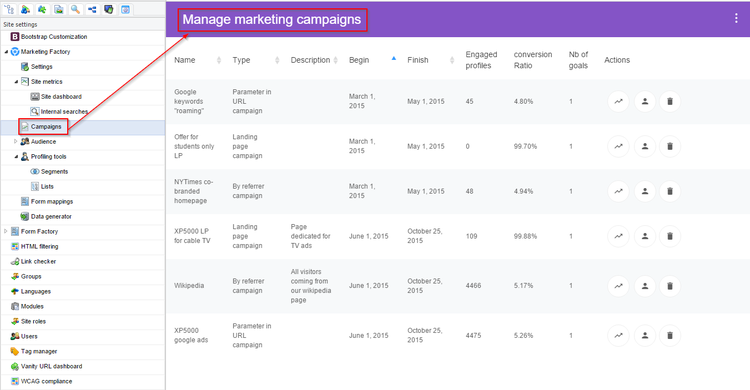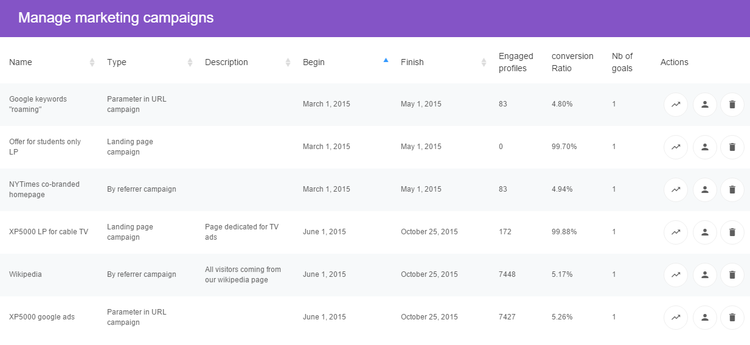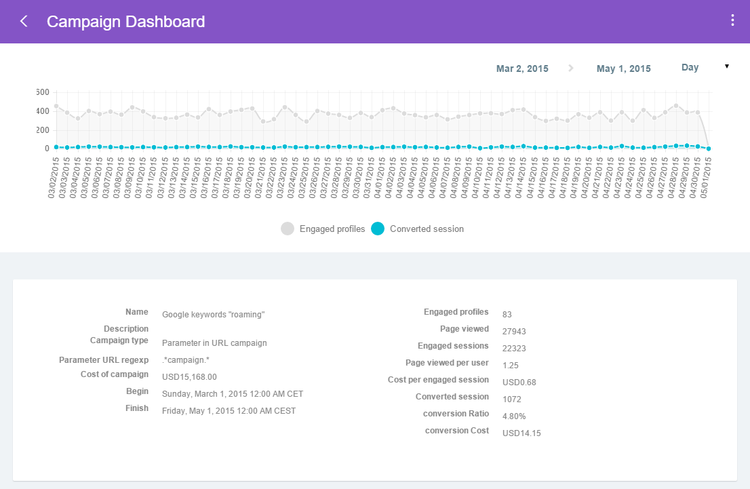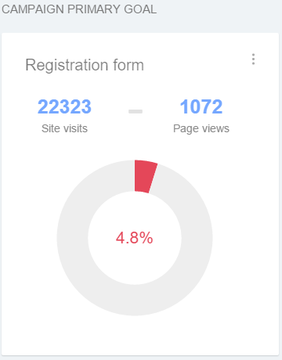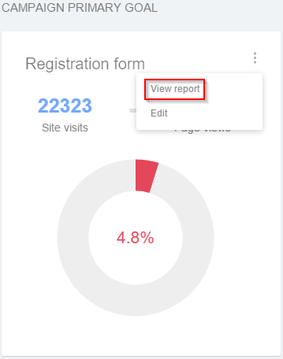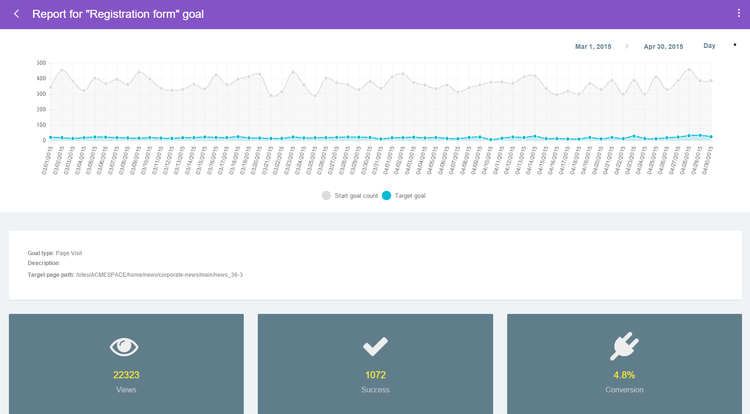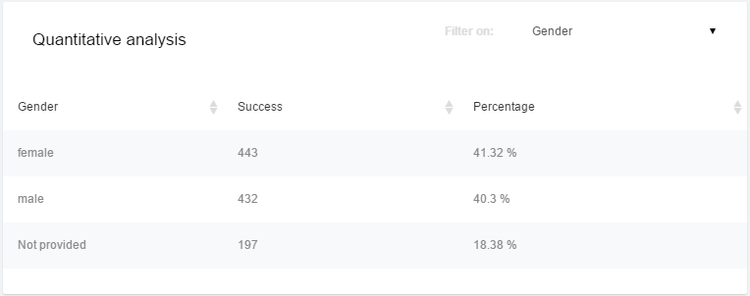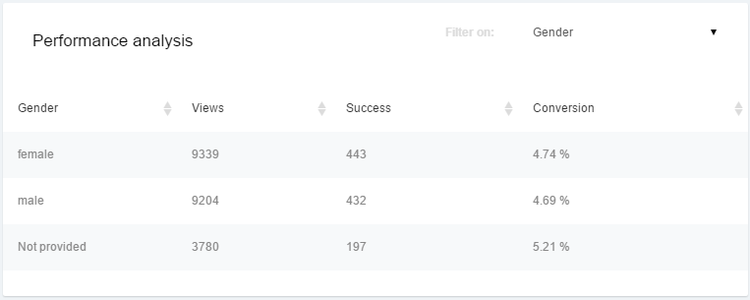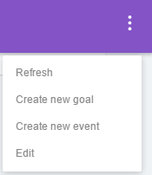Campaigns tracking
A campaign is a marketing initiative, online or offline, which has the purpose of bringing people to a website and, usually, motivating visitors to execute a specific action. Marketing Factory allows you to track your campaigns to see how they perform, do in-depth analysis of the visitors who were attracted by these campaigns and actually performed the expected action (goal). Marketing Factory lets you determine which campaigns are the most successful ones and generate the higher return on investment (ROI).
You can specifically target visitors who are reacting to a campaign and execute personalization, testing or other marketing-oriented tasks.
Goals are meant to track the internal performance of your website
Campaigns tracking allow you to track the performance of an external campaign (SEM, SEO, social networks, external links, blog article ..).
1 How campaigns work
A campaign is a marketing initiative you have launched to bring visitors to your website. This initiative can be online: a drip campaign by email, rotating banners on web sites, paid keywords, a social post on Facebook, etc. It can also be an off-line initiative: TV or paper ads, printed product brochures or catalogs, QR Codes on POS material, Smart Tags, direct mail or even street-marketing actions.
Whatever the attraction mechanism is, the objective is to motivate a prospect to click on a link or CTA (if it is an online campaign) or, later (if the campaign is off-line), to type an Internet address that will bring them to your website. To be able to measure the efficiency of a campaign, the first critical key is to identify the fact that those visitors are coming because of your campaign.
1.1 Identify visitors
First, Marketing Factory needs to identify visitors that have been exposed to your campaign so it can start counting and monitoring them correctly. People identified as coming because of a campaign are considered engaged.
To assert that visitors are coming to your site because of one of your campaigns, there are two main cases:
- Your campaign has been designed to send visitors to a specific address (URL) that is (normally) not accessible with standard navigation, like a specific landing page, but - apart the fact that people access this page - you do not have more details. That is usually the case with print marketing, street marketing and any other types of off-line campaigns when visitors cannot click or activate a link.
- Your campaign brings people to your website, to a dedicated or not dedicated page (like your home page or a campaign related product page) by following a link, which provides an identifier that allows you to know that they are coming because they have been exposed to your campaign and clicked on that particular link. This is the case for most online initiatives, like: Google ads, banners, etc., but also for off-line marketing actions if you are using smart tags, beacons or QR codes, for instance.
1.2 Campaign Primary Goal
The goal of a campaign is to not only make people come to your site, or even to increase your traffic, but to really engage with them more deeply and start a conversation. Then, once they have arrived on your website, you will want them to perform a specific action that will increase their likeliness to become buyers or brand advocates. Those actions can be, for example, to download a white paper, register for an event / conference / webinar, fill out a contact form, look at a video, ask for a sales representative call, etc.
In Marketing Factory, this very specific action is called the Primary Goal. The number of visitors that react to your campaign and perform the intended activity (we call that engage with the primary goal) defines the success of the campaign.
1.3 Campaign secondary goals
The results of a campaign (conversion rate, cost per converted visitor, etc.) are calculated based on the Primary Goal that is the absolute measure of success. Nevertheless, you may want to add other goals to your campaign in order to track how many visitors are engaged in this campaign their performance compares to these secondary goals.
Goals in a campaign are created and work exactly like goals for your site metrics (see the chapter Goals and the chapter Concepts for detailed information about the reporting and analysis capabilities). The only difference is that only people engaged in your campaign will be considered for the statistics. If, for instance you run a campaign based on Google ads that brings visitors to a page named Our new XP5000 mobile phone, and if that page is accessible from your standard site navigation, you will have visitors coming because of your campaign AND people that came to your site and to this page without being exposed to this campaign. By setting a goal for this page visit in your campaign dashboard, Marketing Factory will show you the statistics only for those people that have been identified as engaged in your campaign.
2 Campaigns default page
The campaigns default page lists all campaigns by date of creation and provides critical information about each campaign like the number of engaged visitors and the conversion rate.
The buttons in front of each campaign, 

Seeing the list of engaged visitors.

3 Create a campaign
To create a campaign, follow this procedure:
- Click on the Campaign entry in the left menu.
- Click on the top-right menu.
- Choose Create new campaign.
- Give your campaign a meaningful name (Mandatory).
- Give your campaign a meaningful description (Optional, but recommended).
- Enter the amount spent (Optional).
- Set a start date.
- Set an end date.
- Save.
The form disappears and the list of campaigns is refreshed. Your new campaign should appear inside.
Once your campaign has been created in Marketing Factory, you can add campaign goals. The goals created in the context of a campaign work exactly like goals declared for your website, except that only the subset of visitors engaged in your campaign will be taken into account.
4 Campaign dashboard
The campaign dashboard provides a detailed view of how your campaign perform.
The first section is the timeline showing the number of engaged visitors and the number of conversions:
5 Primary Goal results
As for any goal in Marketing Factory, you can access a detailed report of that goal using the top-right menu and choosing View Report.
And then access the quantitative and qualitative analysis of visitors who achieved that goal.
For detailed explanations about analysis capabilities, please refer to chapter 2 Concepts.
5.1 Update the campaign
Using the top-right menu:
You can:
- Refresh the campaign page.
- Create a new goal for that campaign. As explained previously, only people engaged in your campaign will be accounted for the new goal.
- Create a new event. The event will appear in your campaign timeline.
6 Engaged users report
This screen lists all the visitors engaged in the selected campaign
6.1 Using the tools above the list of profiles
You can:
- Do a full text search on all profiles included in the list by using the search field. The list of matching profiles is displayed in real-time under the search field as you type.
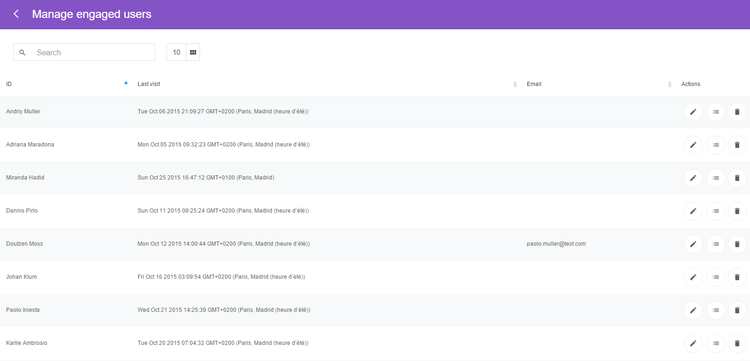
Beware that this search feature works on all profiles properties, not only names. As a consequence, you may have to dig into the profile details to see where the search term is being used in the profile. - Change the columns that are displayed. A click on the icon opens the list of available properties. Check or uncheck the properties you want to display in the table.
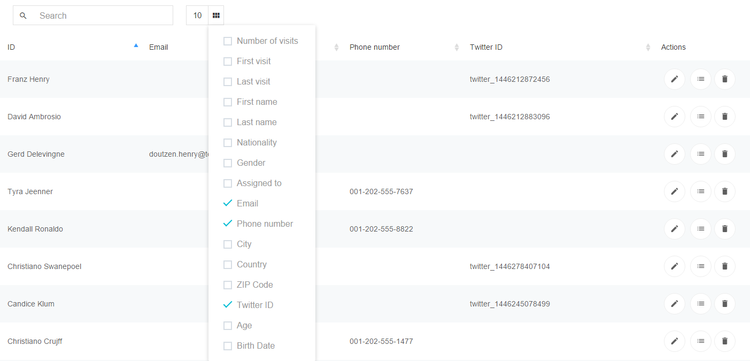
The changes occur in real-time; you can check / uncheck several items.
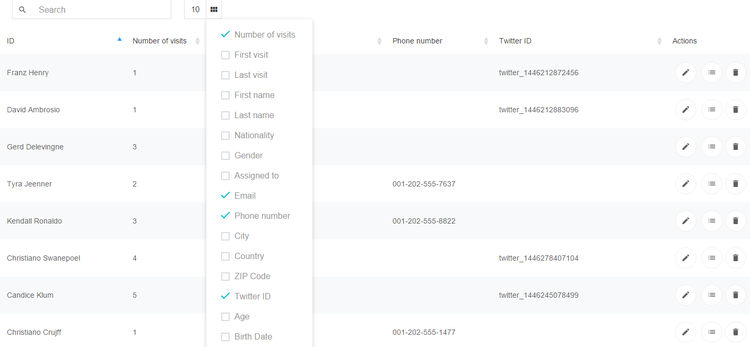
Finally, click outside of the drop-down menu to see your updated screen, which can be very different from its original state.
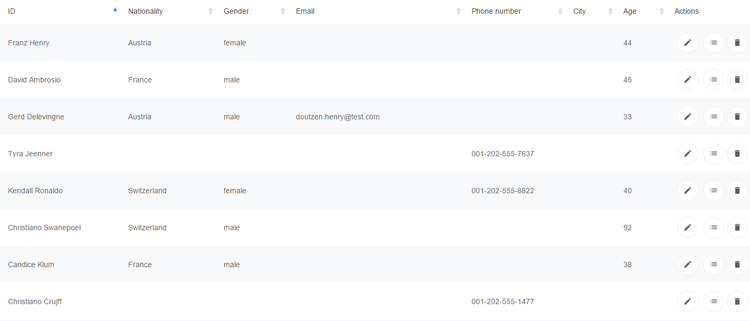
6.2 Campaign events
A campaign is sometimes done of multiple initiatives or submitted to revisions during its course (like raising or lowering a budget, relaunching a drip emailing, etc.). Marketing Factory offers the possibility to add so called events to a campaign so you can keep the memory of what has been done and try to monitor the impact of some decisions.
To create a new campaign event
- Go to the campaign dashboard
- Click on the top-right menu
- Choose Create a new event
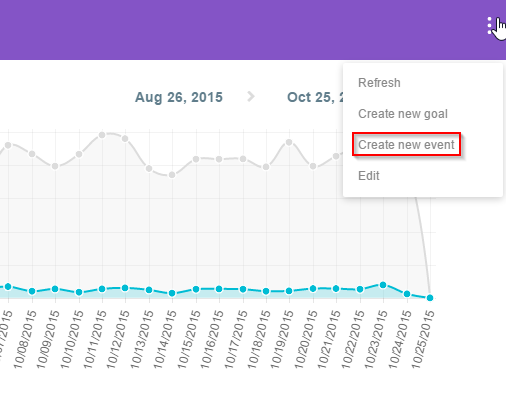
- Fill the form
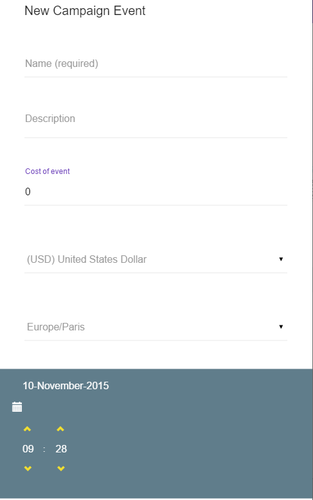
- Save
Once a campaign event has been created, it appears in the time line, highlighting the date of the event.
Details about this event appear lower in the dashboard
Campaign events are just informative; they are not affecting calculations in any way.
7 Advanced use of campaigns
Declaring your campaigns in Marketing Factory is not only useful to get performance statistics. You will also want to analyse the audience engaging to your campaign and who of them achieved the primary goal with the objective to improve the user experience.
7.1 Campaigns and segments
You can define a boolean segment property requiring a user to be engaged in the campaign
7.2 Campaigns and personalization
You can use the fact that a visitor is engaged in a campaign as a trigger for personalization.
7.3 Campaigns revival
You can easily extract the visitor segment that engaged in a campaign by expressing some interest for your campaign topic but then did not reach the Primary Goal.
You can also use the fact that a visitor is engaged in a campaign and has fulfilled the primary goal to go a step further and do a follow-up. Depending on your primary goal, the follow-up can be cross-selling, a personalized offer, a conversation with a sales representative, a meeting in a showroom, etc.
7.4 Campaigns and interests
If a visitor is engaged in a campaign, it means that the visitor has reacted to your campaign by clicking on a link or by typing an address in a browser. This means that most likely the visitor is more interested in the topic of your campaign than the average visitor. This information can be translated into interest points, which can be added to his or her profile. If the visitor performs your primary goal, additional points should be granted.
Jeff is the Product Manager in a telecom company. He is responsible for a new offering on a worldwide high-speed Internet access for $10/month. The offer has been defined but will not be available for another three months because of technical details. Because Jeff fears that competitors may launch a similar offer faster than his company, he wants to move fast and decides to launch aggressive campaigns to generate pre-registration and qualified leads he will be able to re-contact when the subscription is available.
Jeff creates a dedicated website http://www.worldwidefor10bucks.com to present this offer, with a home page and three other pages that explain the details of the offering. The home page contains a call to action that leads to a form to register for the offer.
Jeff spent $500K in Google ads. Those ads will send visitors to the home page of his site with a special parameter in the URL that is passed on by Google. Using Marketing Factory, Jeff declares this campaign, sets the Google tracking number and defines the pre-registration form as the main goal. Jeff also defines 3 page visit goals (one for each 2nd level page of his site) because he wants to evaluate if people just fill the form or go reading the offer details and which one.
Jeff spends $300k in TV ads on local cable networks, promoting the Internet address http://www.worldwidefor10bucks.com/cableoffer, which contains another call to action with a special rebate for immediate registration. He declares that campaign, its cost and sets the same form as primary goal.
Finally, Jeff spends $200k in a drip campaign. First, he uses Marketing Factory to extract all visitors that have visited the pages talking about LTE, international coverage, roaming; then he exports this list into a CSV format and imports the list into Marketo. The email contains a link to the home page http://www.worldwidefor10bucks.com with a special tracking ID that Jeff declares in a third campaign.
Looking at the results he knows instantly:
How many visitors were engaged in each campaign.
How many visitors converted by completing the pre-registration form.
The cost per converted user for each campaign.
How fast and for what duration each campaign has attracted visitors.
He can compare the return on investment (ROI) of each campaign and then decide to stop or invest more in the campaign(s) that provide the best results.
Digging into the reports, Jeff learns that 16% of the engaged people that did not convert are already customers that opted-in for the newsletter on the company customer site so he will be able to send a more targeted email to those customers. Also, digging into the results of the primary goal, Jeff discovers that conversion rates are very good for people from the West coast, especially if they connect from a Mac or an iPhone. Looking at his site, he sees that the home page uses an iPhone image, which may lead visitors to think that the offer is only for Apple users. Based on this information, he can decide to personalize his next message or the landing page to focus on this Mac/IPhone uses or to try to raise the conversion rate for the non Mac/IPhone visitors.
